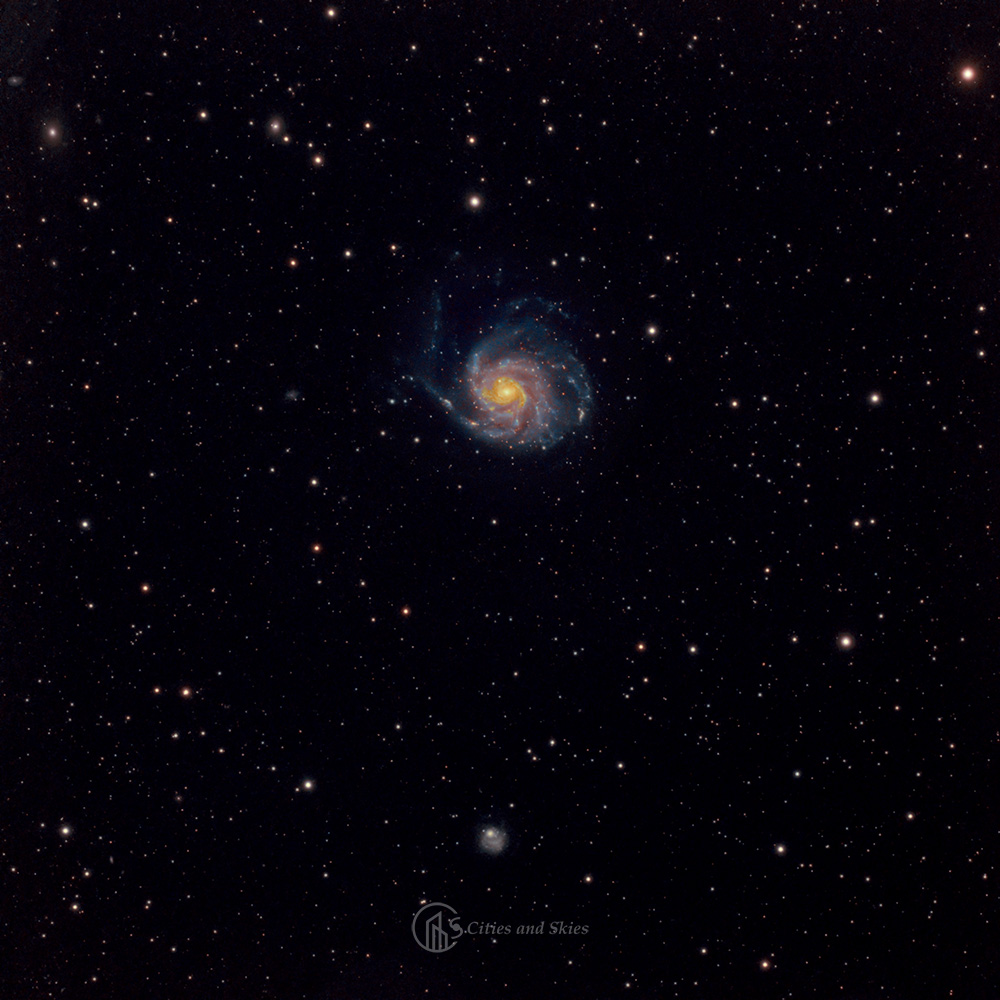Small telescope astrophotography, from a town with light pollution? Here we show you how we captured the Pinwheel Galaxy (M101) from our hometown. Emission nebulae are easy because they are large, and they show a large contrast with respect to the sky background when observed using special nebula filters as we did for the Rosette Nebula, for example. Galaxies may be fun to photograph when they are in a group, like Markarian’s Chain. But individual, small galaxies can be difficult targets since they are rather faint, and tiny.
Small telescope astrophotography of galaxies
Light pollution is a problem in general, but it makes astrophotography of galaxies with a small telescope especially hard. And here I am not talking about the low-Earth orbit satellites threatening our skies, but just plain bright skies due to excessive street lighting in towns. The light from Galaxies is dominated by starlight, which is similar to that of the Sun. They shine in the visible spectrum (from red to blue) and beyond. The are broad-band light pollution filters that let most of this light in the telescope, but block some parts of the spectrum where street lighting is typically strong. We use the Optolong L-Pro filter.
Our case is complicated because we have street lights right in front of our front door, and also one right next to our back garden. These are so strong that they illuminate our camera sensor and cause reflections even is the telescope is not pointing right in their direction. That is why we decided to build a temporary structure each night when we take photos, to block the street lights. We started doing this when we started the project on the Pinwheel Galaxy – this video (made months later) shows the process.
The Pinwheel Galaxy
The Pinwheel Galaxy or Messier 101, is located in the Ursa Major constellation. It is one of the popular galaxies targeted by amateur astronomers. Probably because it has a prominent and somewhat twisted spiral arm structure, with very active star-formation regions. The size of Messier 101 is almost twice of the Milky Way galaxy. At the distance of 6.4 megaparsecs (21 million light-years) it apparent size is 23×24 minutes of arc, which is roughly 2/3d that of the Full Moon. But it still appears rather small in our images and having a camera with small pixels of 3.76 microns is an advantage. Our telescope has only a (reduced) focal length of 384 mm, which gives a nice field of view, but a relatively mall magnification of ~7.5x with prime focus imaging (magnification ~ 384 mm/50 mm).
Galaxies also have “satellites”
An advantage of this telescope configuration though that shows the surroundings of the Pinwheel Galaxy. There are a number of small/faint other galaxies in the field, which become visible if you brighten your monitor (and know where to look!). Among them is NGC5474, well visible at the bottom of the image. This is a satellite galaxy to Messier 101, meaning that they are gravitationally bound.
Simulations show that NGC5474 was actually shooting right across the spiral structure of the Pinwheel Galaxy, getting distorted in the process, and probably contributing to the spiral arm twists of Messier 101. These galaxy interactions form an important part of galaxy evolution, but they can also trigger an increased rate of star formation, and they can turn on the activity of the central supermassive black holes in the nuclei of galaxies, too! Impressed? – get a small telescope and get to work!
Observing log
5-6 March, Friday night. All clear, just above 0 degrees. Last chance for a long time! In the back garden piled up garden furniture/pillows to shadow light from the lamp just outside. Started preparation already at ~20h. After the first two shots, things restarted, to bring in the satellite galaxy a bit better. The session went till ~6 am, just before sunrise. Very excited to see the results of an ~8hr run on this interesting target… It was only clear till frame 70. Had to delete 71-75, and then from 79 onwards everything. Sad, but still quite a good run on a single object. 74×5 mins.
13-14 April, Tuesday – clear skies predicted for the whole night. The first part of the night is for M101, starting around 10 pm. Like last time, just a few degrees above zero, and built a cushion castle to block the street light. Luna checked it in and out and approved it (then slipped, fell into the agave pot, and run away in shock). The plan was to do ~4h on M101 and move to V1405 Cas (Nova Cas 2021) after 2 pm but started autorun with 60x300s (I cannot flexibly choose, the shorter option was 30x300s, too short). But I slept in, so the run went till 3 am in the morning. We did 53 shots on M101.
M101, Pinwheel Galaxy ~10.5h, from Hoogeveen, Netherlands
5-6 March 2021, 74x300sec with gain 240, -20 deg.
13-14 April 2021 (New Moon), 53×300 sec with gain 101, -20 deg.
Telescope: William Optics GT81, f/5.9, with Flattener 6AIII 0.8x
Camera: ZWO ASI533MC-P
Guidescope: WO Uniguide 50/200 with ASI120MMmini
Mount & control: iOptron CEM40, ASIair Pro
Filter: Optolong L-Pro
Software: Astro Pixel Processor, Photoshop
